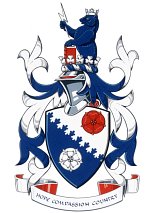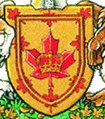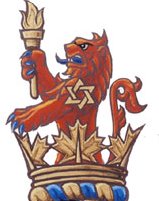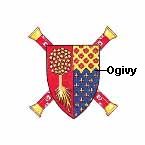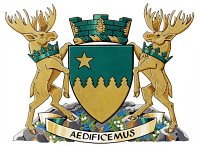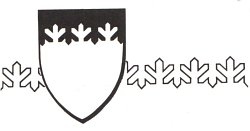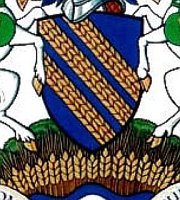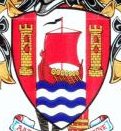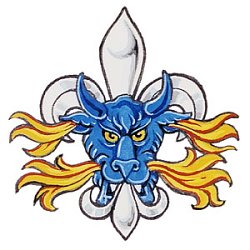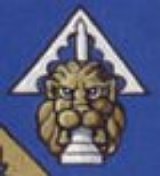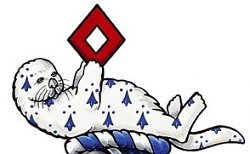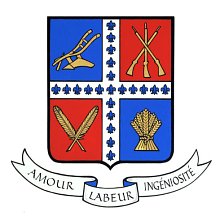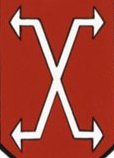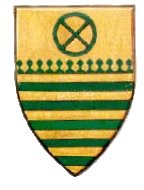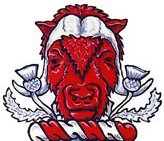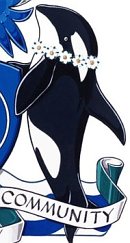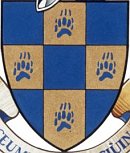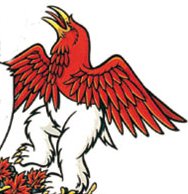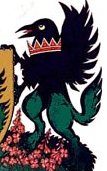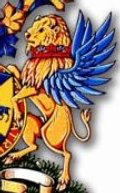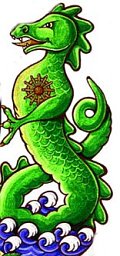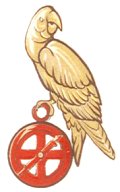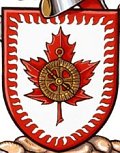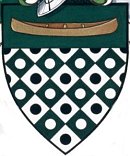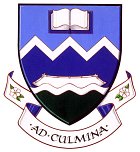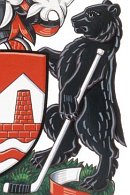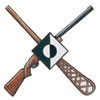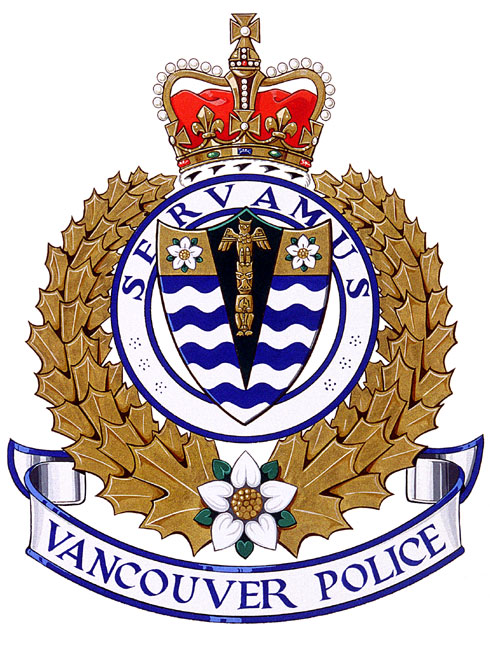| CANADIAN INNOVATIONS IN HERALDIC CHARGES, by Bruce Patterson and Kevin Greaves |
The following charges or terms of blazon have been developed in Canada or, in a few cases, revived from terms originating in Britain but little used in modern times.
1. LINES OF PARTITION
Érablé means a division line of alternating maple leaf shapes (e.g. per bend érablé). The term can also be applied to a tressure, such as that to the Monarchist League of Canada, or to a coronet set with maple leaves.
Per Bend Érablé
A Tressure Érablé
A Coronet Érablé
Ogivy means a division line in the form of a Gothic arch.
Sapiné means a division line in the form of alternating fir trees.
Per Fess Ogivy
Per Fess Sapiné
Sapinagé means a division line of alternating fir twigs.
Tapissé means a division line or ordinary made up of ears of grain, although thus far always with wheat.
A Chief SapinagéThree Bends Tapissé of Wheat
Other Lines In two grants to Saskatchewan corporate bodies (St. Paul's Cathedral, Regina, and the Royal Saskatchewan Museum) there is a line "indented in the form of poplar leaves".
2. ORDINARIES
A Canadian Pale means a pale occupying one-half of the width of the shield or banner, as first used in the Canadian Maple Leaf Flag. Its use in flags has been extensive, and the practice has also been extended to arms, the term indicative of a particularly wide pale.
Canadian PaleCanadian Pale
Canadian Fess The equivalent of the above, has been used once, for the City of Burnaby, B.C.
3. OTHER ATTRIBUTIVE TERMS
Jessant In several cases new forms of "jessant" have been used: Claire Boudreau's badge is a panther's head jessant-de-lis, and the arms of Richard Jones include lion heads each jessant of a pheon, combining a favourite animal of his with a heraldic charge traditionally associated with Joneses.
Jessant de Lis
Jessant of a PheonFlotant The grant to Gary Mitchell features a sea otter as the crest. It is shown on its back with its head slightly raised, the normal position for sea otters when at rest. Heraldically, this attitude is described as flotant, a term previously used in reference to ships and flags.
In Bivuac A recent grant to the Carrière Family Association of North America includes a figure of three muskets resting against each other, blazoned as in bivouac.
Otter Flotant
Muskets in Bivuac
Rustré A "resurrected" term is rustré, which means lozengy; each lozenge pierced. Claire Boudreau located it in a mediaeval treatise, and it was used in the grant to R.C. Purdy's Chocolates.
4. TINCTURES
Rose, a term for a pink colour, has appeared on occasion, such as in the grant to the Rt. Hon. Kim Campbell and in a few instances to describe pink flowers.
Copper A new metal, Copper, was introduced for the grant to Eric Nisbet-Brown. In general, the darkness of Copper as compared with Or will keep its use limited.
Ermine Variations of ermine with different colours have been introduced, a notable example being the Gules semé of ermine spots Argent in the supporters of the arms of the Rt. Hon. Antonio Lamer, the former Chief Justice of the Supreme Court of Canada, as a reference to the red and white judicial robes of the high court.
5. TECHNOLOGICAL CHARGES
Hexagons A construct of hexagons representing network pathways of computer connections was the major charge on the grant to James Kiang:
Crossconnect A computer symbol called a crossconnect was used in the arms of Ian McDonald, a computer scientist, at the suggestion of Kevin Greaves.
Construct of Hexagons in SaltireCrossconnect
6. ABORIGINAL SYMBOLS
Medicine Wheel The medicine wheel appears in the arms of the Royal Museum of Saskatchewan.
Infinity Sign The infinity sign from Métis flags has been used in the armorial bearings of several people of Métis heritage and in the arms of a school in Montreal named after Louis Riel.
Medicine Wheel
Infinity SignOther Aboriginal Symbols include a wampum belt (City of Windsor), and a calumet, a type of pipe, in the arms of Legislative Assembly of Ontario.
7. CANADIAN ANIMALS AND BIRDS
Animals that have been used in grants have included the bison, muskox, wolverine, killer whale, narwhal (RHSC), and lynx (the Hon. Maurice Sauvé).
Paw Prints An interesting application has been the use of animal paw prints, which have appeared in four Canadian grants: two of bear paw prints, one of wolf and one of badger.
Musk-oxKiller Whale
Bear Paw PrintsBirds that have appeared in Canadian heraldry have included the loon, the Canada goose, (Gander NL), the ptarmigan (Fermont, QC), and the gannet (Percé, QC).
8. MONSTERS
Fused Monsters The fusing of the upper half of one animal with the lower half of another is one way to create a monster, a prominent example being the raven-bear supporters of the Canadian Heraldic Authority itself, or in the raven-wolf supporters of the Hon. John Kenneth McKinnon, former Commissioner of the Yukon Territory.
Raven-bear
Raven-wolf
Winged Monsters The addition of wings or a fish tail to a creature is frequently used, such as the winged bison supporters for the Hon. Peter Liba. the sea caribou for the Royal St. John's Regatta Committee, or the winged sea rams for the Canadian War Museum.
Ogopogo In terms of "existing" Canadian monsters, the lake monster Ogopogo is one of the supporters assigned to the City of Penticton, B.C.
Winged BisonOgopogo
9. OBJECTS
Structures An igloo appears as the crest of the Territory of Nunavut, and in the arms of Jeffrey Gilmour, a longtime resident of the Arctic. Other examples of particularly Canadian structures include the sod house, a feature of the pioneer period on the prairies.
Astrolabe There are manufactured objects that have a particular association with Canada, one example being the astrolabe of early explorers (the one that allegedly belonged to Champlain is now in the Canadian Museum of Civilization). This appears in the arms the Museum itself, and in several other grants.
Astrolabe
AstrolabeCanoes Canoes have a special place in Canadian identity, and a number have been included in grants, including both modern and traditional First Nations styles.
Canoe (Eastern Woodlands)
Canoe (West Coast)
Other Boats that have appeared in grants include a Cape Breton schooner and a York Boat.
Hockey and Lacrosse Sticks, indicative of Canada's national sports, have made several appearances.
Hockey Stick
Lacrosse StickMission Cross A cross terminating in spruce tree shapes has been devised for communities that originated as religious missions. This is known as a Mission cross.
10. ECCLESIASTICAL HERALDRY
The Cathedra A bishop's chair (cathedra) has been used as a supporter for the arms of an Anglican Cathedral. We now categorize such elements not as granted emblems but rather as forms of display (i.e., a cathedra is no longer blazoned as a supporter, and a mitre is not blazoned as a crest).
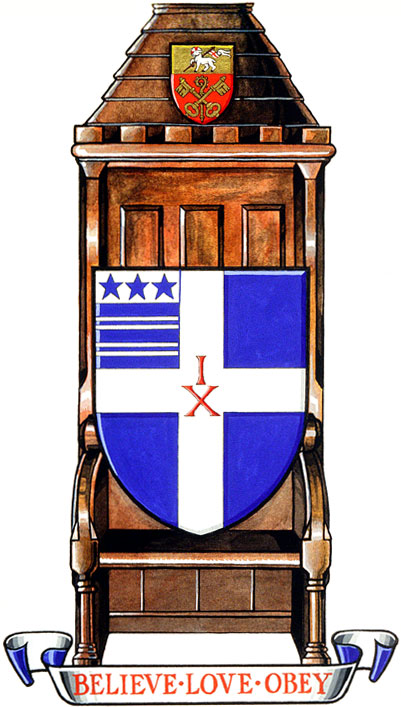
11. POLICE SERVICE BADGES
Inspired by the badge of the Royal Canadian Mounted Police, and ultimately by military unit badges, many municipal police services in Canada have been granted a badge, the basic pattern of which shows the arms of the municipality at its centre with a wreath of maple leaves around a circlet bearing the police service motto, arising from the provincial flower at the base and ensigned by the Royal Crown. This is the preferred, although not the exclusive, design for police badges, and several variations have been used as well.
Municipal Police Badge
Copyright © All Rights Reserved. Bruce Patterson & Kevin Greaves, September 17, 2006.
Released: January 12, 2004
Updated: April 5, 2007







